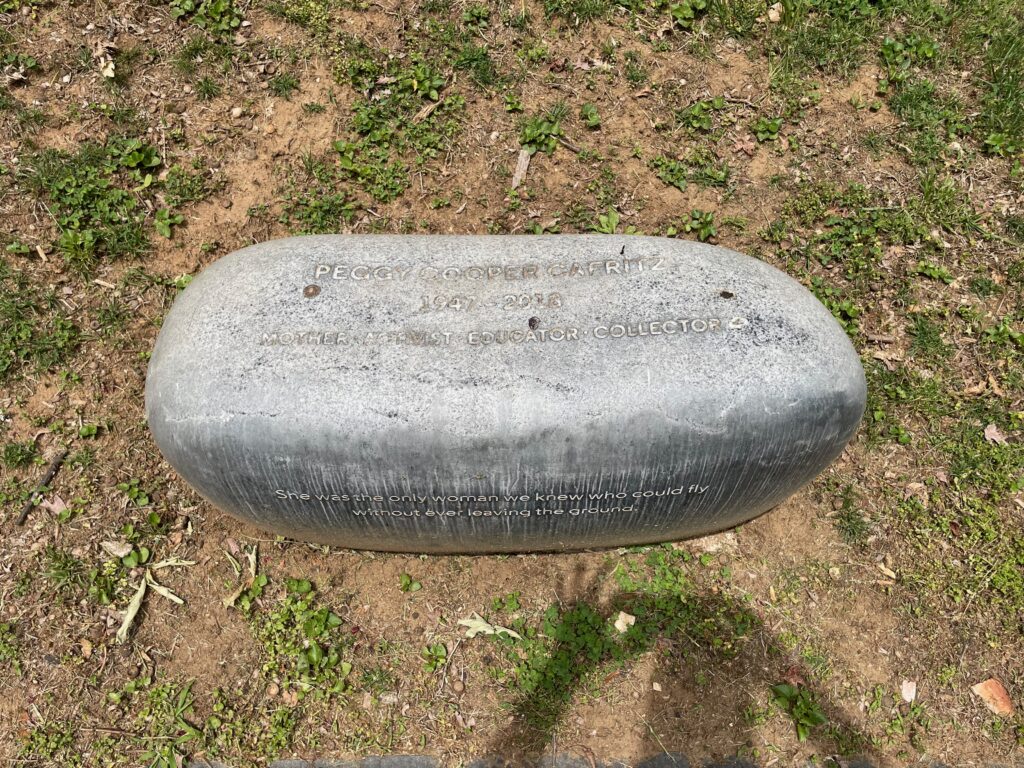Erik Visits an American Grave, Part 1,384
This is the grave of Peggy Cooper Cafritz.

Born in 1947 in Mobile, Alabama, Pearl Cooper was always known as Peggy and in fact legally changed her name later. She was born into the Black elite in Mobile, which for the postwar Black community, actually was pretty wealthy. Like, the family was friends with Duke Ellington level of wealthy. The money came from where it usually did during the Jim Crow South. Someone had to provide basic services to the Black community in a segregated world where whites wouldn’t touch their money. So her father owned insurance companies and mortuaries around Alabama that served the Black community. Moreover, they were Catholics, which both then and now is a sign of elite status in the Black community.
From the time she was a girl, Cooper was into art. Her parents were rich enough to own a good print of Georges Braque and she credited that with her love of art. The timing of her life also meant she grew up within the civil rights movement. Although some members of the Black elite, especially ministers of their churches, did not really embrace the movement at first, threatened by the loss of their power and wealth (and let’s be clear, when segregation ended, it really did decimate higher end Black businesses), this does not seem to be the case for Cooper’s parents. So when Martin Luther King came to Mobile, they didn’t just go see them. He came to their house and probably stayed the night. At the same time, she was reading James Baldwin and other leading Black writers. A specifically Black consciousness was born.
Her parents also actually wanted her to experience racism. That was pretty easy to do in the Catholic Church. When she was 10, they sent her to an all white Catholic summer camp in Michigan. Oh she experienced all the racism. She called home crying. Her parents said tough, welcome to being Black in America, learn to live with it. Then they made her go back the next year too. And when the local Jesuit high school wouldn’t take her and her brother, her parents sent them to a nearly all-white Catholic boarding school in Indiana. Again, they were not going to sympathize with complaints about racism. It’s an interesting call for parents to make. But it sure placed in her a tough exterior and a complete lack of patience with racial oppression.
When she was back at home in the summer of 1964, she and her friends decided to enforce the recently passed Civil Rights Act. They went to a drive in restaurant. But local whites, mostly young punks, surrounded the car, spat on them, and basically acted like the racist trash they were. Mobile would not be desegregated that day and she avoided the city for the rest of her life as much as possible.
That fall, Cooper started at George Washington University and Washington would be her home for most of her life. But GW was still pretty segregated. She and the other Black students started the Black Student Union there and went far to promote Black rights on campus. Now, she was not necessarily a political figure. Her real love was art, not politics. But the art world was largely closed to Black people. That’s what she wanted to change as she became an adult. In 1968, her senior year at GW, she organized a Black Arts Festival that both promoted the artistic talents of young Black kids in Washington and connect them up with the professional community there. This became a yearly event.
She got a law degree from GW in 1971. She became an assistant to Harry Belafonte, got to know Jacob Lawrence, and got a job producing documentaries for the PBS station in Washington, winning Emmy and Peabody awards for her work. She continued her educational art work as well and in 1974, founded the Duke Ellington School for the Arts. This has been a huge force in the Black artistic community for nearly a half-century as well, with an endless number of prominent alums.
In 1981, Cooper married the real estate developer Conrad Cafritz, a Jewish man from huge money. They had worked together for years in the art community. They became major buyers of African art, as well as of leading Black American painters. They divorced in 1998 after he cheated on her. Sadly, the house with all her art burned in 2009 and most of it was lost, but they rebuilt their collection.
By the end of her life, Cafritz was one of DC’s leading art patrons, as well as a trustee of the National Film Institute and on one of the Whitney Museum’s acquisition communities. She also helped finance Spike Lee’s Malcolm X. She was a close friend of Bill Clinton and that whole community around him, especially Vernon Jordan. She died in 2018, at the age of 70.
Peggy Cooper Cafritz is buried in Oak Hill Cemetery, Washington, D.C.
If you would like this series to visit more members of the Black arts community, you can donate to cover the required expenses here. Jean-Michel Basquiat is in Brooklyn and Augusta Savage is in Hartsdale, New York, Previous posts in this series are archived here and here.


